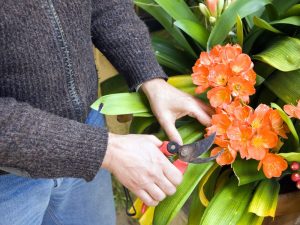Last Updated on April 30, 2024 by teamobn
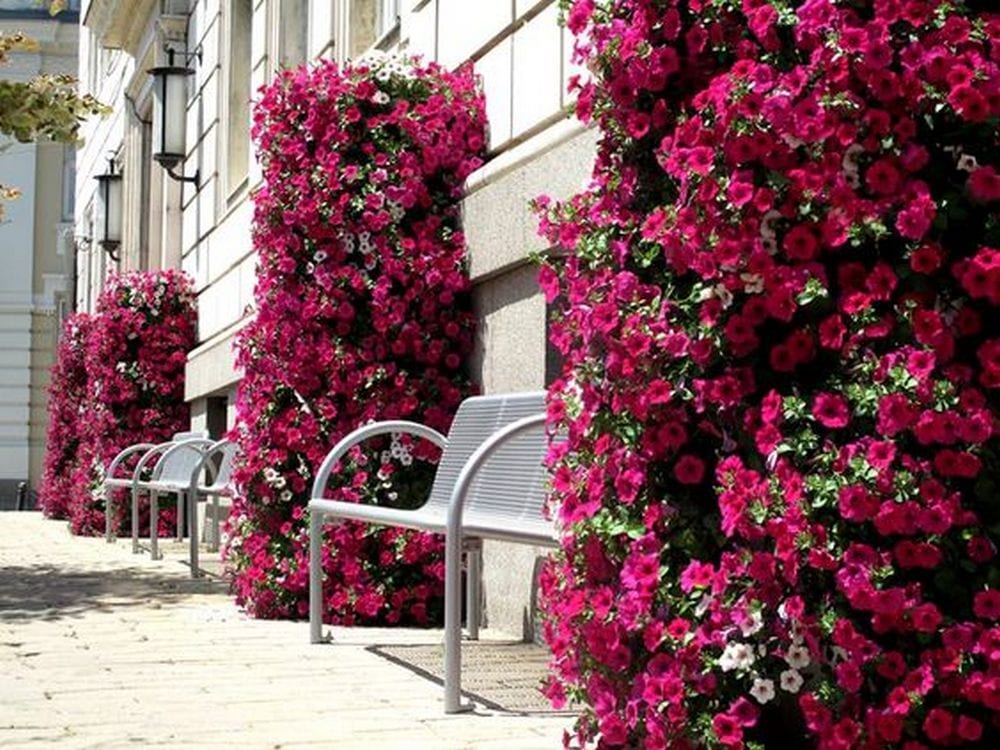
Are you looking for new ways to brighten up your garden? If you want something fun, you’ll surely like this DIY flower tower project. Flower towers are a great idea. They’re a colorful addition to your yard or garden. Plus, the height will help you maximize space. This is very helpful if you live in a house with a small yard. More so, if you don’t want the commitment of having to tend to a big garden.
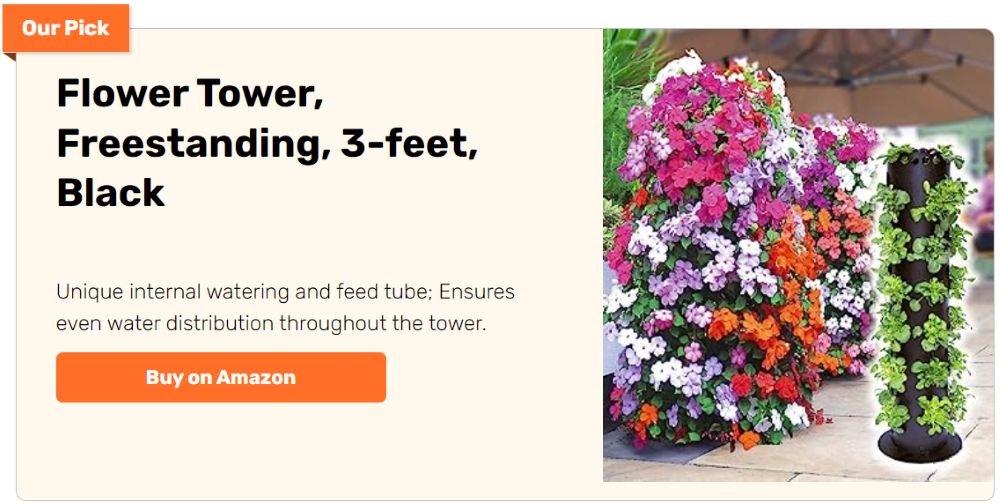
Making a flower tower is easy. It may look complicated and difficult but really, it’s not. In fact, you will be able to make one in just a couple of hours. The best part is, you may even already have the materials needed to make one. This means you won’t need to buy the supplies so you save money.
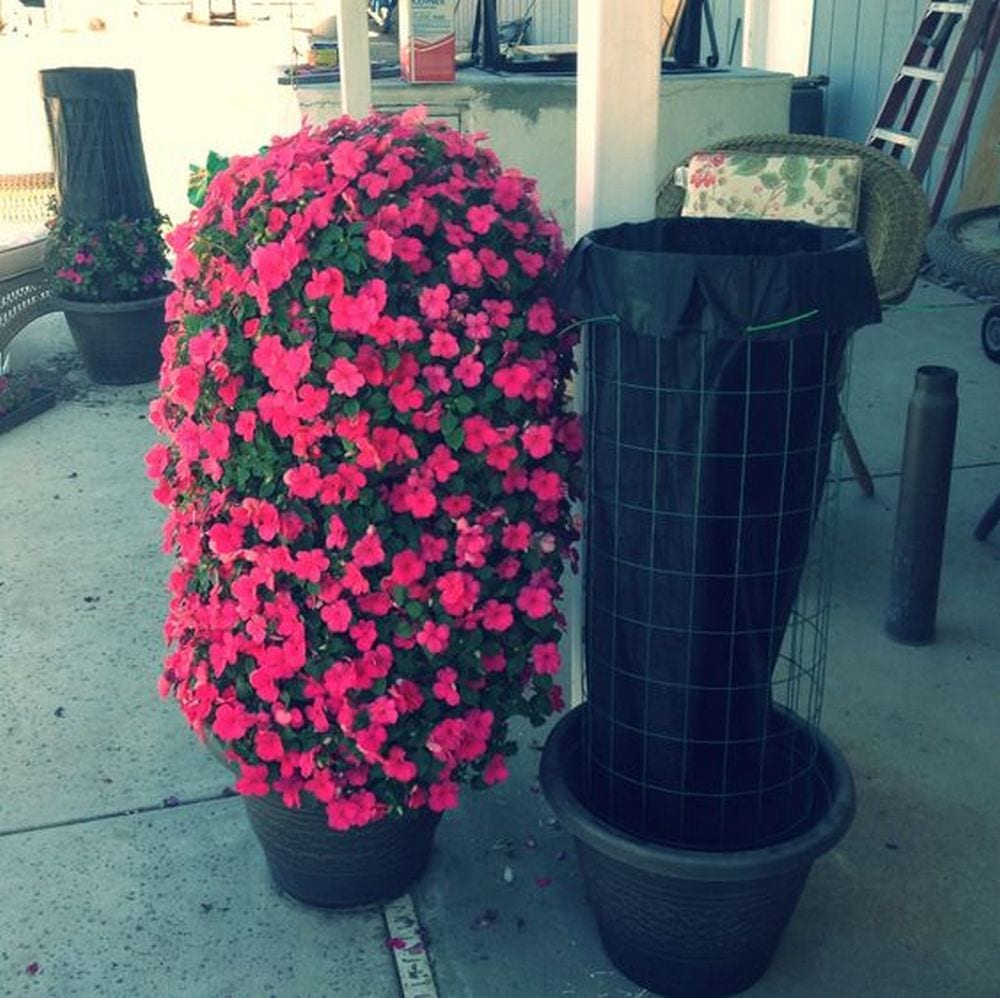
Introduce a new attraction in your garden with the use of flower towers. Once your plants are in full bloom, you’ll realize your efforts are well worth it. Start making your own flower today and enjoy its beauty!
Making a Flower Tower
Contents
Materials
- Wire fencing
- Flowers
- Potting soil
- Landscape fabric
- Flower pot
- Zip ties
Tools
- Fertilizer spikes
- Hand shover
- Tin snips
- Scissors
- Water hose
- X-acto knife
- Gloves
Instructions
Step 1: Prepare Your Base
- Choose a stable and suitable location for your flower tower.
- Place the flower pot at this location. This will serve as the base of your tower.
Step 2: Cut and Shape the Wire Fencing
- Wear gloves to protect your hands.
- Using tin snips, cut the wire fencing to the desired height and width. It should be tall enough to create a substantial tower but manageable for you to work with.
- Shape the cut wire into a cylinder that fits snugly into the flower pot.
Step 3: Secure the Cylinder
- Use zip ties to secure the ends of the wire fencing together, forming a stable cylinder.
- Ensure there are no sharp edges exposed that could harm the plants or yourself.
Step 4: Line with Landscape Fabric
- Cut the landscape fabric using scissors or an X-acto knife to fit inside the wire cylinder.
- Line the inside of the wire fencing with the landscape fabric. This will help retain the soil and prevent it from washing out.
- Secure the fabric with additional zip ties if necessary.
Step 5: Fill with Soil
- Mix potting soil with fertilizer spikes to provide nutrients to the flowers.
- Gradually fill the tower with soil, compacting lightly as you go to eliminate air pockets.
Step 6: Plant Your Flowers
- Start planting flowers at the top of the tower and work your way down, adding more soil as needed.
- Use the hand shovel to make small openings in the landscape fabric. Insert the flowers into these openings.
- Ensure even spacing and adequate soil around each plant for stability and growth.
Step 7: Water Your Flower Tower
- After all flowers are planted, water the tower thoroughly using a water hose.
- Ensure that water reaches all parts of the tower, adjusting the flow to avoid soil erosion.
Step 8: Ongoing Care
- Water the flower tower regularly, especially during dry spells.
- Check periodically for weeds and remove them.
- As the plants grow, they may need additional fertilizer or adjustments to their positioning in the tower.
Click on any image to start the lightbox display. Use your Esc key to close the lightbox.
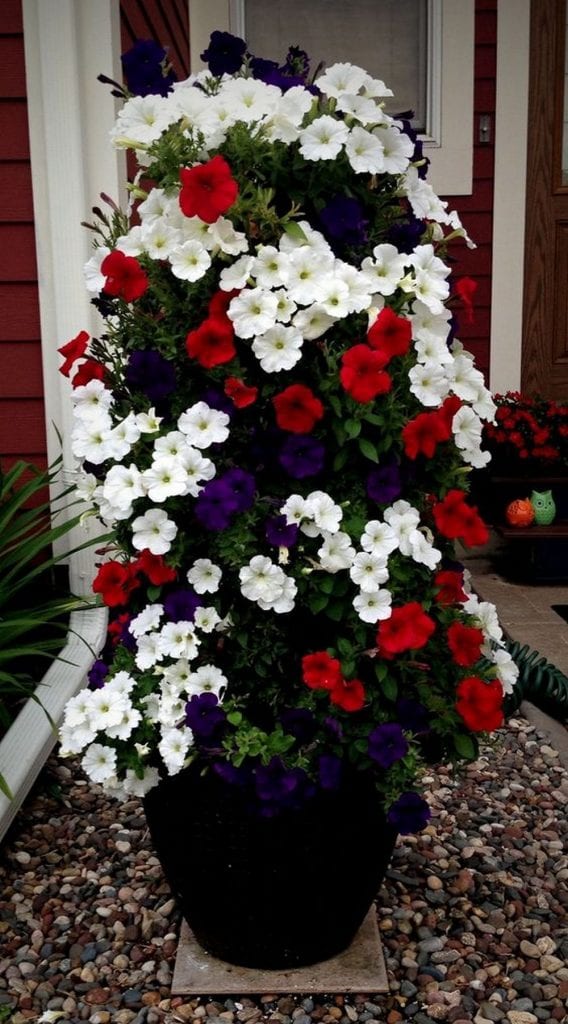

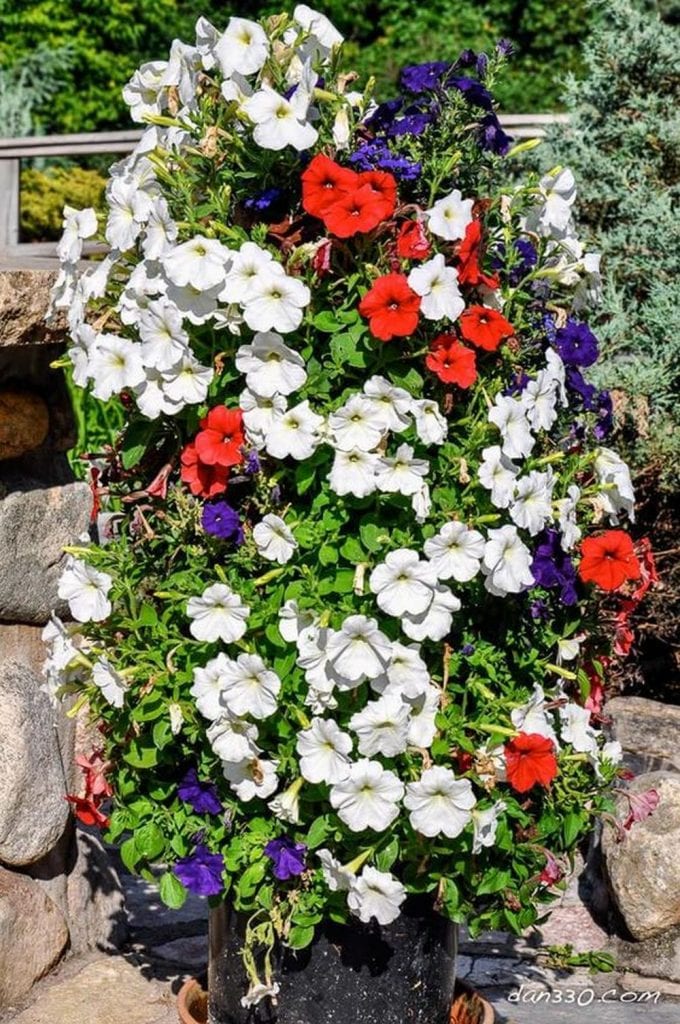



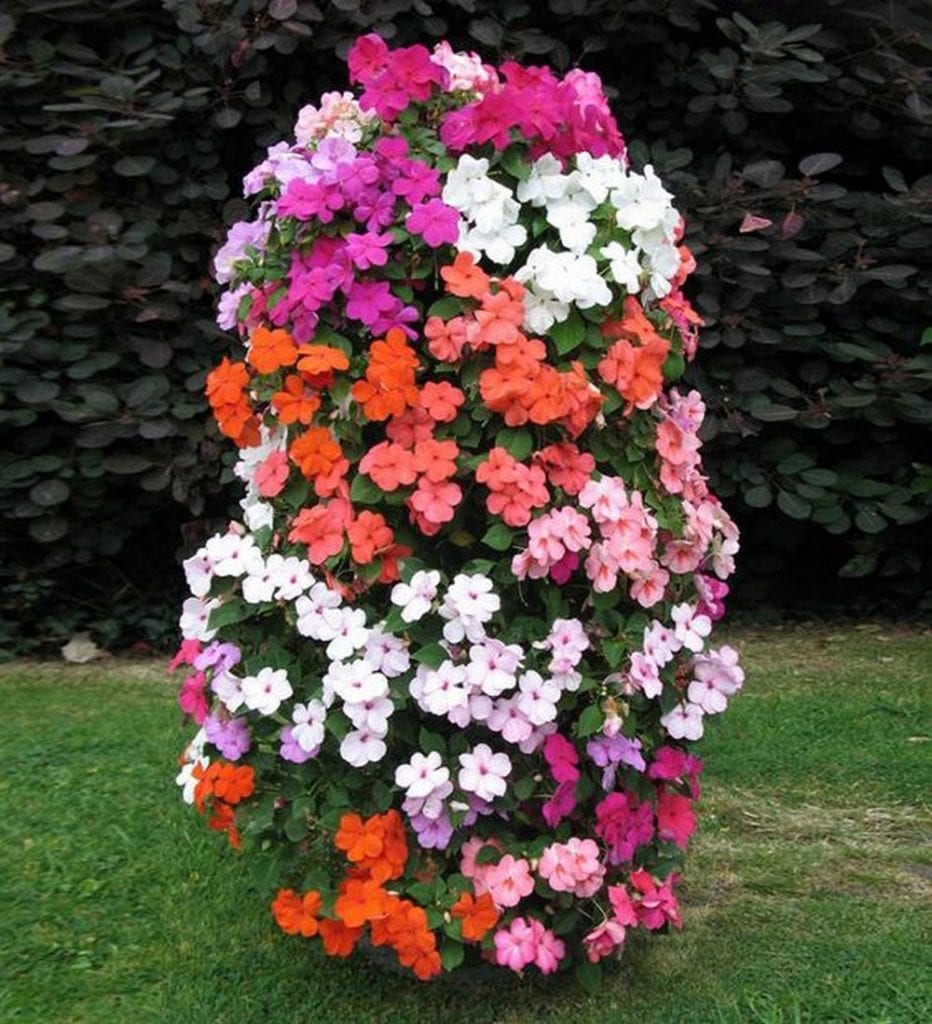

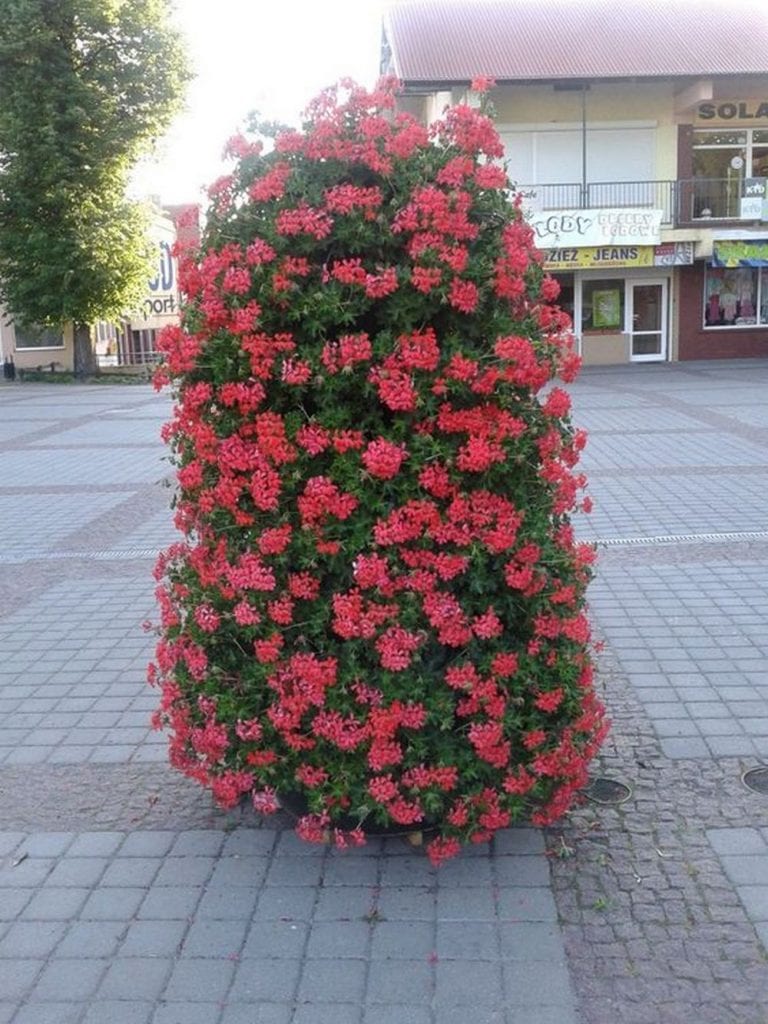
For a visual guide to making your flower tower, check out the video below.
Choosing the Right Flowers for Your Tower
Creating a flower tower is an excellent way to add a vertical element of beauty to your garden. However, the success of your tower largely depends on the types of flowers you choose.
Here’s a guide to selecting the right flowers for your flower tower, ensuring vibrant blooms and a thriving garden display.
Consider the Climate
Firstly, consider the climate in your area. Some flowers thrive in cool temperatures, while others prefer warmth. Choose species that are well-suited to your local weather patterns to ensure your flower tower remains healthy and colorful throughout the season.
Sunlight Requirements
Evaluate the amount of sunlight your flower tower will receive daily. Select flowers based on their sun requirements:
- Full Sun: Choose flowers like marigolds, zinnias, or petunias if your tower is exposed to six or more hours of direct sunlight a day.
- Partial Shade: For areas receiving about three to six hours of sunlight, consider impatiens, begonias, or ferns.
- Shade: If your flower tower is in a mostly shaded area, opt for hostas or astilbe.
Blooming Periods
To maintain a visually appealing flower tower throughout the gardening season, select flowers with varying blooming periods. This strategy ensures that when one type starts to fade, another begins its display. For instance, combine early bloomers like crocuses with mid-season tulips and late bloomers like chrysanthemums.
Growth Habit and Size
Consider the growth habits and sizes of the flowers:
- Vertical Growers: Flowers like snapdragons and foxgloves add height and drama to the top and middle tiers of your tower.
- Cascading Plants: For the edges and lower parts of the tower, choose cascading flowers such as trailing petunias or ivy geraniums to create a waterfall effect.
Color Coordination
Think about the color scheme of your flower tower. You can create a monochromatic look with varying shades of the same color, or you can opt for a vibrant mix to make a bold statement. Consider how the colors will blend or contrast with the surroundings in your garden.
Maintenance Needs
Some flowers require more maintenance than others. If you prefer a low-maintenance garden, opt for drought-resistant and hardy varieties like sedums or lavender. High-maintenance flowers, while often more striking, will require more frequent care and attention.
By carefully selecting the right flowers considering these factors, your flower tower will not only thrive but also become a central feature of your garden. Enjoy the process of planning and planting, and soon you’ll see your efforts come to life in a beautiful vertical display.
Decorative Ideas for Flower Towers
Flower towers provide a unique vertical element to any garden, offering a fresh and eye-catching way to display blooms. Whether you’re looking to add a splash of color or create a functional centerpiece, the right decorations can enhance the beauty and impact of your flower tower.
Here are some creative ideas to decorate your flower tower, ensuring it stands out and complements your outdoor space.
Use of Color
- Vibrant Colors: Select bright and bold flowers to create a striking visual impact. Bright reds, yellows, and oranges can energize a space, while deep blues and purples add a touch of sophistication.
- Pastel Palette: For a softer, more romantic vibe, use pastels like soft pinks, light yellows, and baby blues. These colors blend well with rustic or shabby chic garden styles.
Adding Textures
- Mix Foliage and Flowers: Incorporate various types of foliage to add texture and depth. Ferns, ivy, and ornamental grasses can provide greenery that complements colorful blooms.
- Varied Bloom Sizes: Combine flowers of different sizes and shapes to create a more dynamic and layered look. For example, large dahlias paired with fine-textured baby’s breath.
Lighting
- Fairy Lights: Wrap fairy lights around the tower structure for a magical evening glow. This not only highlights the flowers but also creates a charming ambiance after sundown.
- Solar Lights: Embed solar lights within the flower arrangements to illuminate the tower at night, enhancing both the visibility and attractiveness of the display.
Decorative Elements
- Ribbons and Fabrics: Tie ribbons or strips of fabric around the tower for a festive or seasonal touch. Choose materials that can withstand outdoor conditions.
- Themed Decorations: Align the tower’s decorations with seasonal themes or upcoming holidays. Use pumpkins and gourds in the fall, or bright ribbons and eggs for Easter.
Use of Containers
- Contrasting Pots: Use pots in varying colors, sizes, or styles to add interest at the base of your tower. This can also help in integrating the tower more seamlessly with the rest of your garden’s decor.
- Decorative Mulch: Top the soil with decorative mulch like colored pebbles, tumbled glass, or cocoa hulls for a clean and polished look.
Seasonal Accents
- Seasonal Touches: Adapt your decorations with the seasons to keep your garden feeling fresh and timely. Incorporate autumn leaves in fall, fresh sprigs of holly in winter, or vibrant tulips in spring.
Artistic Flair
- Garden Art: Integrate small statues, decorative stakes, or whimsical garden gnomes around the base or within the structure to create points of interest and conversation pieces.
Natural Enhancements
- Stones and Rocks: Arrange stones or decorative rocks around the base for a natural, grounded appearance. This can also help with soil moisture retention.
Vertical Accents
- Hanging Ornaments: Suspend small lanterns, wind chimes, or hanging crystals from the structure to catch the light and add movement and sound to your garden setup.
By incorporating these decorative ideas into your flower tower design, you can transform a simple structure into a stunning garden feature. These enhancements not only boost the aesthetic appeal but also reflect your personal style and creativity.
Conclusion
Creating a flower tower is a rewarding DIY project that adds a unique vertical element to your garden. With the right selection of flowers and decorative touches, you can transform a simple structure into a stunning focal point. As you maintain and update your flower tower throughout the seasons, it continues to bring beauty and joy to your outdoor space.




